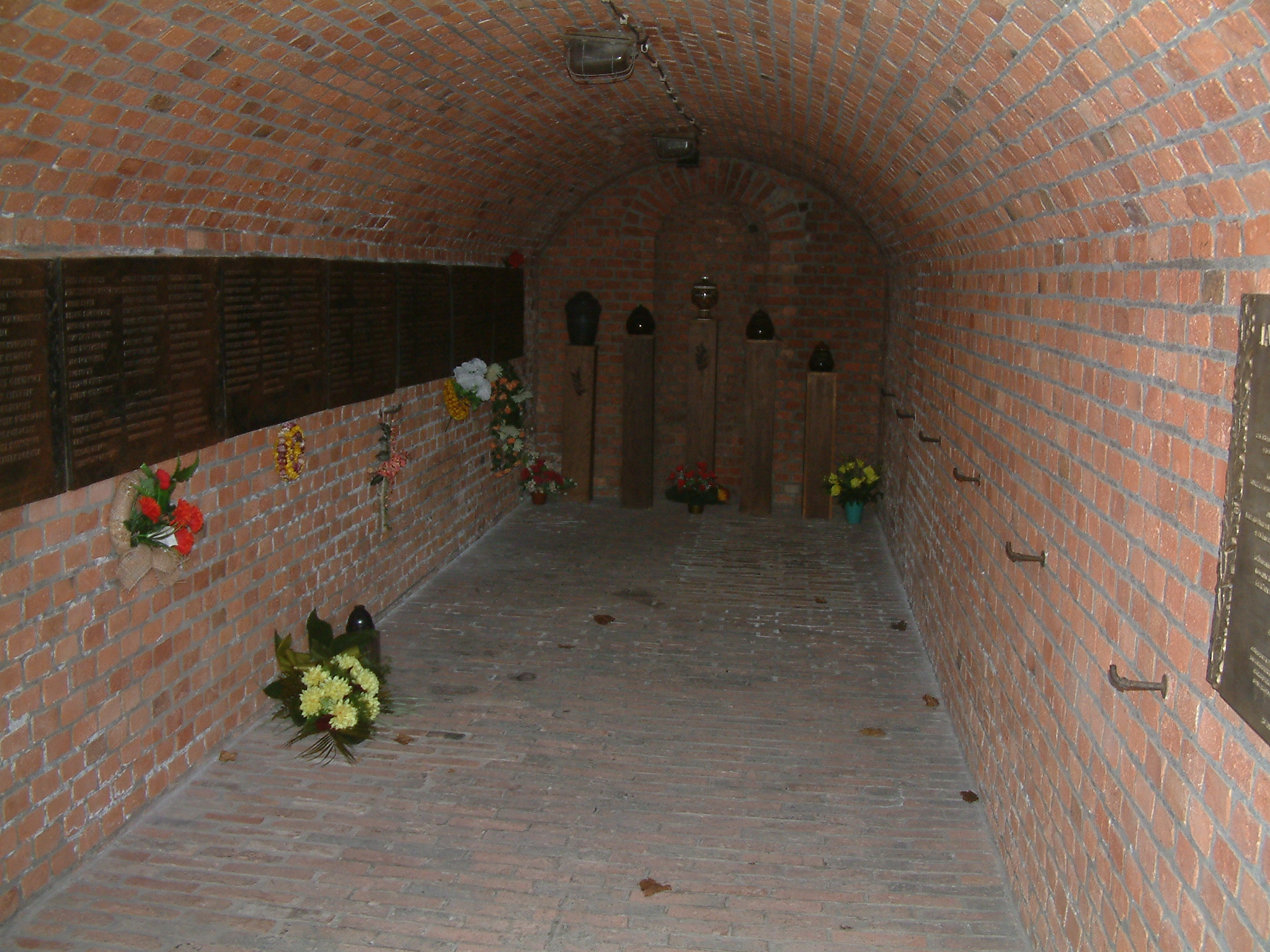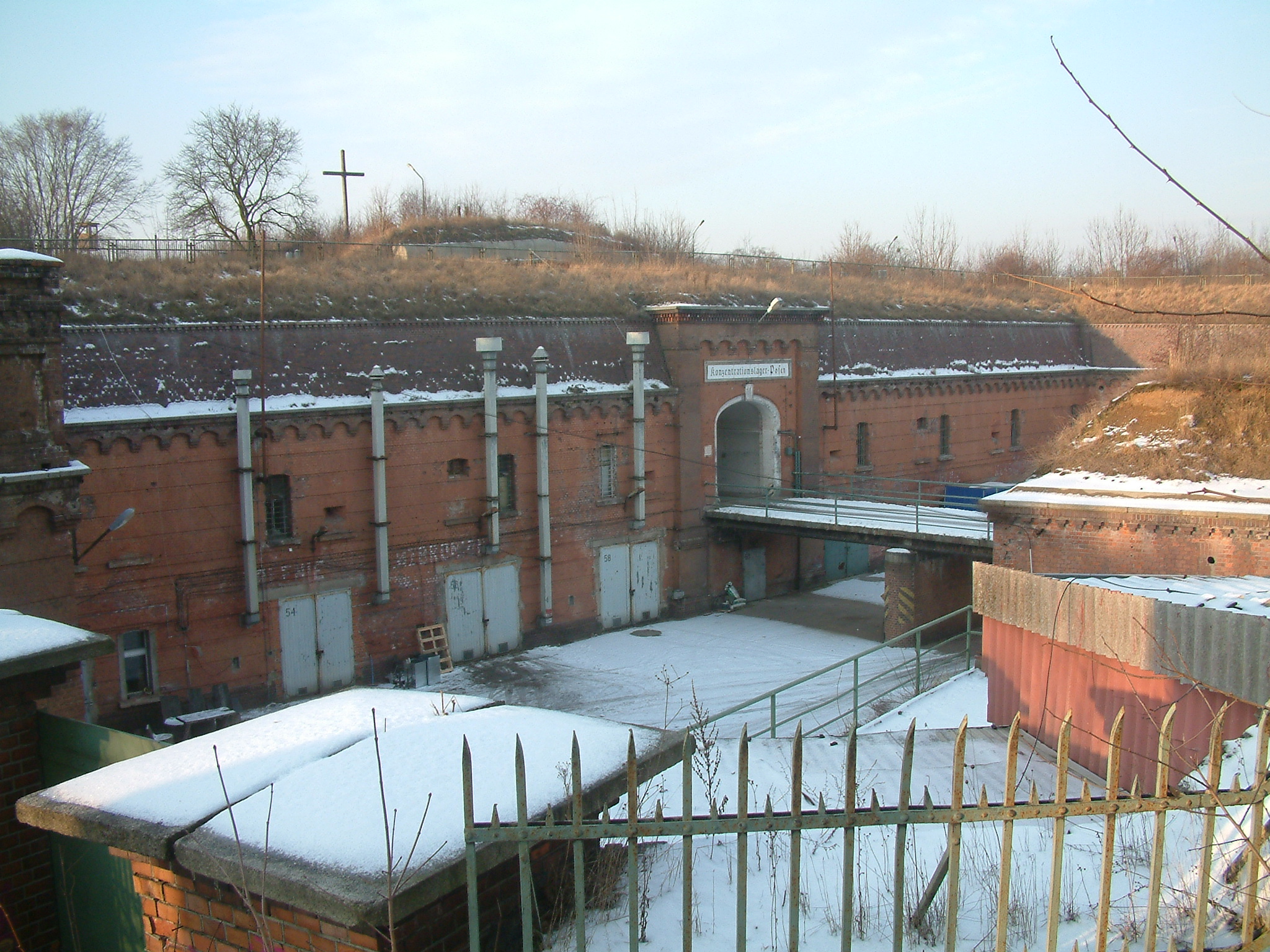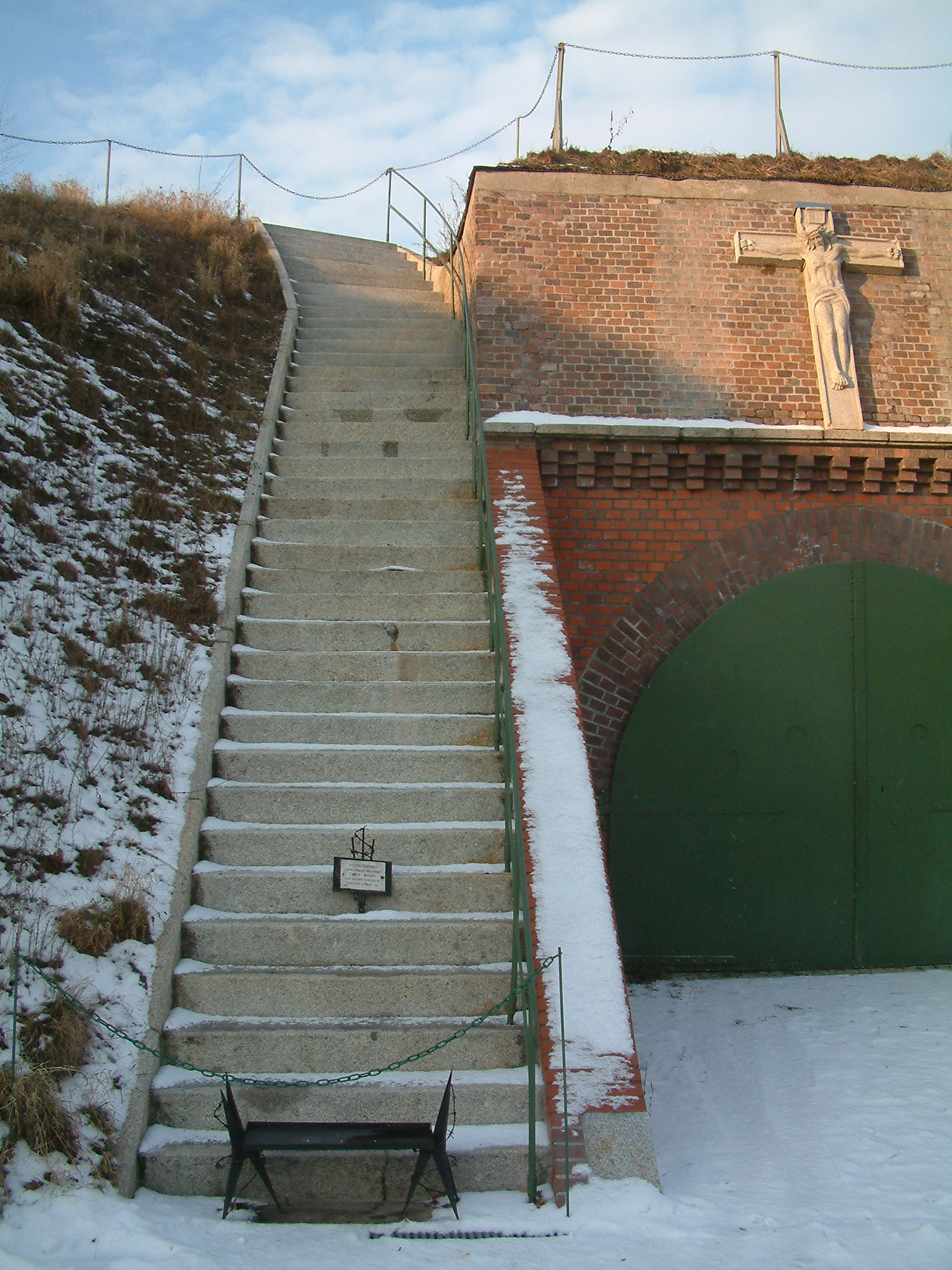Fort VII on:
[Wikipedia]
[Google]
[Amazon]
Fort VII, officially ''Konzentrationslager Posen'' (renamed later), was a Nazi German
 Following the German invasion of Poland in September 1939, Fort VII was chosen as the site of the first concentration camp in occupied Poland, called ''Konzentrationslager Posen''. It was probably created by decision of the ''Reichsstatthalter'' of the PoznaŇĄ region, Arthur Greiser. It began functioning at some time around October 1939. The prisoners were mostly Poles from the Wielkopolska region. Many were representatives of the region's
Following the German invasion of Poland in September 1939, Fort VII was chosen as the site of the first concentration camp in occupied Poland, called ''Konzentrationslager Posen''. It was probably created by decision of the ''Reichsstatthalter'' of the PoznaŇĄ region, Arthur Greiser. It began functioning at some time around October 1939. The prisoners were mostly Poles from the Wielkopolska region. Many were representatives of the region's
 About 2,000 to 2,500 prisoners were held at the camp at any one time, guarded by approximately 400 members of the SS. There were 27 cells for men and three for women. According to conservative estimates of the Fort VII State Museum, a total of 18,000 prisoners passed through the camp, of whom 4,500 died. Other estimates put the total number of prisoners as high as 45,000, and the number of deaths at around 20,000. Deaths were the result of either to execution: including shooting, hanging or gassing; mistreatment, torture, and contagious disease.
On the 20 October 1939 the first Jewish victims from Posen (PoznaŇĄ), Benno Rindfleisch and Julius Tychauer, were shot at Fort VII. Several more Jews were shot in the same month in PoznaŇĄ and in nearby Buk and Kornik. But the majority of the Jewish population of Posen was transported to the Lublin district, most likely ultimately perishing at
About 2,000 to 2,500 prisoners were held at the camp at any one time, guarded by approximately 400 members of the SS. There were 27 cells for men and three for women. According to conservative estimates of the Fort VII State Museum, a total of 18,000 prisoners passed through the camp, of whom 4,500 died. Other estimates put the total number of prisoners as high as 45,000, and the number of deaths at around 20,000. Deaths were the result of either to execution: including shooting, hanging or gassing; mistreatment, torture, and contagious disease.
On the 20 October 1939 the first Jewish victims from Posen (PoznaŇĄ), Benno Rindfleisch and Julius Tychauer, were shot at Fort VII. Several more Jews were shot in the same month in PoznaŇĄ and in nearby Buk and Kornik. But the majority of the Jewish population of Posen was transported to the Lublin district, most likely ultimately perishing at
 Fort VII was known among prisoners as a particularly harsh camp, partly because of the high ratio of guards to prisoners (about one to five). Prisoners lived in cramped, dark, damp and cold conditions. Sometimes 200‚Äď300 prisoners were held in a cell measuring 20 by 5 metres. The women's cells, located below ground level, sometimes remained flooded up to knee height.
Until mid-1942 prisoners slept on the floor or on rotting straw. There was little or no access to washing facilities, and parasites and disease spread easily. Prisoners were subjected to torture and humiliation by the guards. On the "stairway of death" prisoners would be made to run up carrying a heavy stone, and possibly kicked down from the top by a guard. Food rations were minimal, as officially the prisoners were not working. However, some of them were made to work in unofficial workshops. Only one prisoner is known to have escaped ‚Äď Marian Szlegel, thanks to his work, was able to identify a time when the camp was less well guarded, and took the opportunity to abscond.
Witness accounts speak of 7 to 9 executions by shooting a day, as well as mass hangings, and shootings of larger groups away from the fort itself. There were two typhus epidemics, each of which killed about 80% of the prisoners held at that time. Many prisoners also died after being taken to other concentration camps.
Fort VII was known among prisoners as a particularly harsh camp, partly because of the high ratio of guards to prisoners (about one to five). Prisoners lived in cramped, dark, damp and cold conditions. Sometimes 200‚Äď300 prisoners were held in a cell measuring 20 by 5 metres. The women's cells, located below ground level, sometimes remained flooded up to knee height.
Until mid-1942 prisoners slept on the floor or on rotting straw. There was little or no access to washing facilities, and parasites and disease spread easily. Prisoners were subjected to torture and humiliation by the guards. On the "stairway of death" prisoners would be made to run up carrying a heavy stone, and possibly kicked down from the top by a guard. Food rations were minimal, as officially the prisoners were not working. However, some of them were made to work in unofficial workshops. Only one prisoner is known to have escaped ‚Äď Marian Szlegel, thanks to his work, was able to identify a time when the camp was less well guarded, and took the opportunity to abscond.
Witness accounts speak of 7 to 9 executions by shooting a day, as well as mass hangings, and shootings of larger groups away from the fort itself. There were two typhus epidemics, each of which killed about 80% of the prisoners held at that time. Many prisoners also died after being taken to other concentration camps.
Museum website: history of the camp
*Marian Olszewski: ''Fort VII w Poznaniu'', Wydawnictwo PoznaŇĄskie, PoznaŇĄ 1974 *Jacek Biesiadka, Andrzej Gawlak, Szymon Kucharski, Mariusz Wojciechowski: ''Twierdza PoznaŇĄ. O fortyfikacjach miasta Poznania w XIX i XX wieku'', Wydawnictwo Rawelin, PoznaŇĄ 2006, {{Authority control Nazi concentration camps in Poland History of PoznaŇĄ Museums in Greater Poland Voivodeship Fort 7 Gestapo World War II museums in Poland The Holocaust in Poland 20th century in PoznaŇĄ
death camp
Nazi Germany used six extermination camps (german: Vernichtungslager), also called death camps (), or killing centers (), in Central Europe during World War II to systematically murder over 2.7 million peoplemostly Jewsin the Holocaust. The v ...
set up in PoznaŇĄ in German-occupied Poland during World War II, located in one of the 19th-century forts circling the city. According to different estimates, between 4,500 and 20,000 people, mostly Poles from PoznaŇĄ and the surrounding region, died while imprisoned at the camp.
Camp establishment
The decades-old Fort VII (also known as ''Fort Colomb'' from 1902 to 1918) was one of the ring of defensive forts built around the perimeter of PoznaŇĄ by the Prussian authorities in the late 19th century, in the second stage of their ''Festung Posen
''Festung'' is a generic German language, German word for a fortress. Although it is not in common usage in English, it is used in a number of historical contexts involving German speakers:
* For historical fortresses in Austria, Germany or Switze ...
'' plan. It was built in 1876‚Äď1880 (with improvements in 1887‚Äď1888). At present, it stands in the western part of the city, on today's ''ul. Polska'' in the Ogrody neighbourhood, part of JeŇľyce district. In the interwar period
In the history of the 20th century, the interwar period lasted from 11 November 1918 to 1 September 1939 (20 years, 9 months, 21 days), the end of the World War I, First World War to the beginning of the World War II, Second World War. The in ...
it was used for storage purposes.
intelligentsia
The intelligentsia is a status class composed of the university-educated people of a society who engage in the complex mental labours by which they critique, shape, and lead in the politics, policies, and culture of their society; as such, the in ...
, often people who had been engaged in social and political life, as well as known Polish patriots and veterans of the Wielkopolska Uprising (1918‚Äď1919) Greater Poland Uprising (also Wielkopolska Uprising or Great Poland Uprising) may refer to a number of armed rebellions in the region of Greater Poland:
* Greater Poland Uprising (1794)
* Greater Poland Uprising (1806)
* Greater Poland Uprising (184 ...
and Silesian Uprisings. In the early stages of the camp's existence prisoners were generally executed within a week of arrival. In October 1939 an early experiment in execution by gas chamber was carried out by an SS chemist, Dr. August Becker
August Becker (17 August 1900 – 31 December 1967) was a mid-ranking functionary in the SS of Nazi Germany and chemist in the Reich Security Main Office (RSHA). He helped design the vans with a gas chamber built into the back compartment u ...
, . 175/sup> whereby around 400 patients and staff from psychiatric hospitals in PoznaŇĄ were gassed at Bunker No. 17. The extermination of mentally ill was conducted by '' SS-Sturmbannf√ľhrer'' Herbert Lange of the Gestapo in occupied PoznaŇĄ. Lange served with '' Einsatzgruppe'' VI during Operation Tannenberg
Operation Tannenberg (german: Unternehmen Tannenberg) was a codename for one of the anti-Polish extermination actions by Nazi Germany that were directed at the Poles during the opening stages of World War II in Europe, as part of the ''Generalplan ...
. He and his men were responsible also for the murder of 2,750 patients at KoŇõcian, about 1,100 patients at OwiŇĄska
OwiŇĄska is a village in the administrative district of Gmina Czerwonak, within PoznaŇĄ County, Greater Poland Voivodeship, in west-central Poland. It lies approximately north of Czerwonak and north of the regional capital PoznaŇĄ. The village ...
, as well as 1,558 patients and 300 civilian Poles at DziaŇādowo; the experience gained allowed Lange to become the first commandant of CheŇāmno extermination camp
, known for =
, location = Near CheŇāmno nad Nerem, ''Reichsgau Wartheland'' (German-occupied Poland)
, built by =
, operated by =
, commandant = Herbert Lange, Christian Wirth
, original use =
, construction =
, in operation ...
(until April 1942).
In mid November 1939 the camp was renamed as a Gestapo prison and a transit camp ''(Geheime Staatspolizei Staatspolizeileitstelle Posen. √úbergangslager ‚Äď Fort VII)''. In this period prisoners usually remained in the camp for about six months, before being sentenced to death, a long prison term or transfer to a larger concentration camp, such as Dachau
,
, commandant = List of commandants
, known for =
, location = Upper Bavaria, Southern Germany
, built by = Germany
, operated by = ''Schutzstaffel'' (SS)
, original use = Political prison
, construction ...
and Auschwitz
Auschwitz concentration camp ( (); also or ) was a complex of over 40 concentration and extermination camps operated by Nazi Germany in occupied Poland (in a portion annexed into Germany in 1939) during World War II and the Holocaust. It con ...
, or in rare cases being released. Prisoners in this period included political and military activists in the Polish Underground State
The Polish Underground State ( pl, Polskie PaŇĄstwo Podziemne, also known as the Polish Secret State) was a single political and military entity formed by the union of resistance organizations in occupied Poland that were loyal to the Gover ...
.
Following Himmler
Heinrich Luitpold Himmler (; 7 October 1900 ‚Äď 23 May 1945) was of the (Protection Squadron; SS), and a leading member of the Nazi Party of Germany. Himmler was one of the most powerful men in Nazi Germany and a main architect of th ...
's decree of 28 May 1941 the camp was renamed as a police prison and corrective labour camp ''(Polizeigefängnis der Sicherheitspolizei und Arbeitserziehungslager)''. In this period some prisoners (called ''niedzielnicy'' in Polish, from the word ''niedziela'', "Sunday") would be held in the camp temporarily between ending work on Saturday and beginning work on Monday.
Prisoner numbers and deaths
Belzec
Belzec (English: or , Polish: ) was a Nazi German extermination camp built by the SS for the purpose of implementing the secretive Operation Reinhard, the plan to murder all Polish Jews, a major part of the "Final Solution" which in total ...
or Sobibor. The prison's documentation was destroyed near the end of the war. According to reports submitted by the prison to the register of deaths, the official number of prisoners who died at Fort VII was 479. Prisoners included citizens of other countries as well as Polish nationals, from the Soviet Union, Yugoslavia, France, the United Kingdom, as well as some Germans.
Conditions
Closure of the camp
From March 1943 the process of gradually liquidating the camp began, so that the site could be used for industrial purposes. Prisoners were made to work on the construction of a new camp south of PoznaŇĄ, in ŇĽabikowo (called ''Poggenburg'' by the Germans), and were then transferred there, the last ones being moved on 25 April 1944. Fort VII became a Telefunken factory producing radio equipment for submarines and aircraft. After the war the building was used as a storage facility by the Polish army. Plans were made in 1976 to turn the site into a museum in memory of the victims of the camp. The museum opened on 13 August 1979, and is called ''Muzeum Martyrologii Wielkopolan Fort VII'' ("Fort VII Museum of the Wielkopolska Martyrs").See also
*List of German concentration camps
According to the ''Encyclopedia of Camps and Ghettos'', there were 23 main concentration camps (german: Stammlager), of which most had a system of satellite camps. Including the satellite camps, the total number of Nazi concentration camps that ...
* Nazi crimes against the Polish nation
Notes
References
Museum website: history of the camp
*Marian Olszewski: ''Fort VII w Poznaniu'', Wydawnictwo PoznaŇĄskie, PoznaŇĄ 1974 *Jacek Biesiadka, Andrzej Gawlak, Szymon Kucharski, Mariusz Wojciechowski: ''Twierdza PoznaŇĄ. O fortyfikacjach miasta Poznania w XIX i XX wieku'', Wydawnictwo Rawelin, PoznaŇĄ 2006, {{Authority control Nazi concentration camps in Poland History of PoznaŇĄ Museums in Greater Poland Voivodeship Fort 7 Gestapo World War II museums in Poland The Holocaust in Poland 20th century in PoznaŇĄ